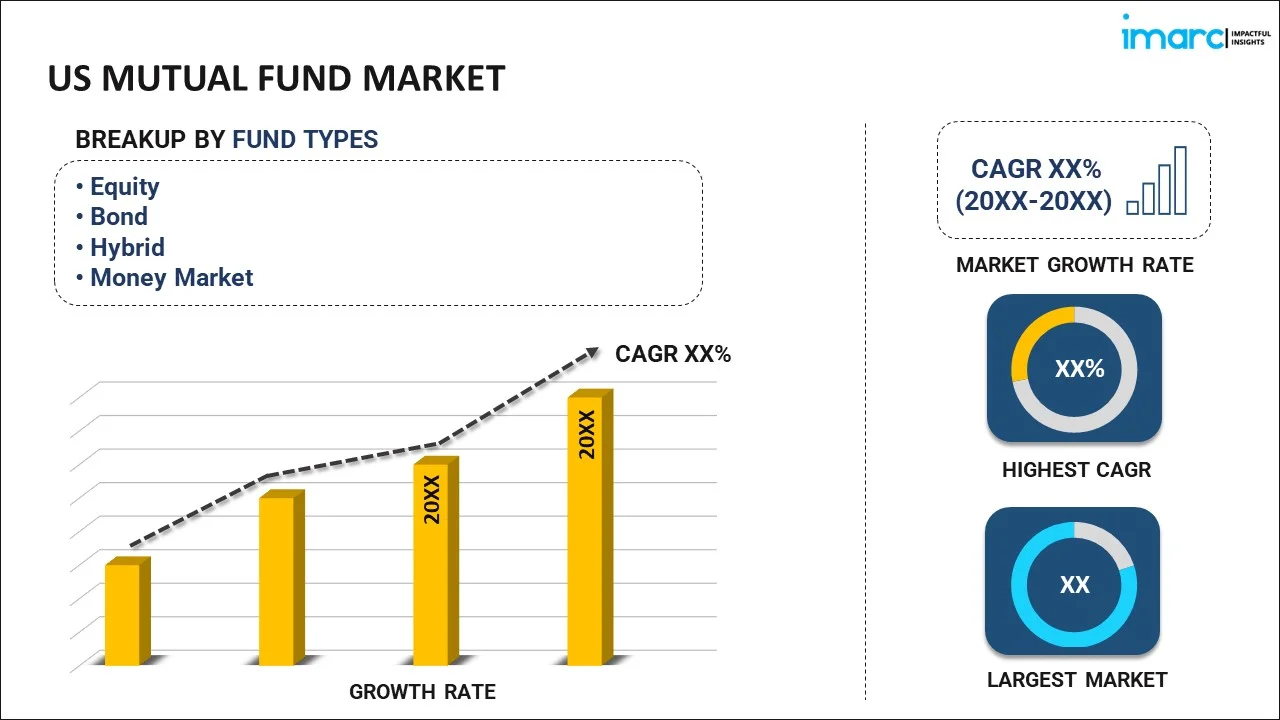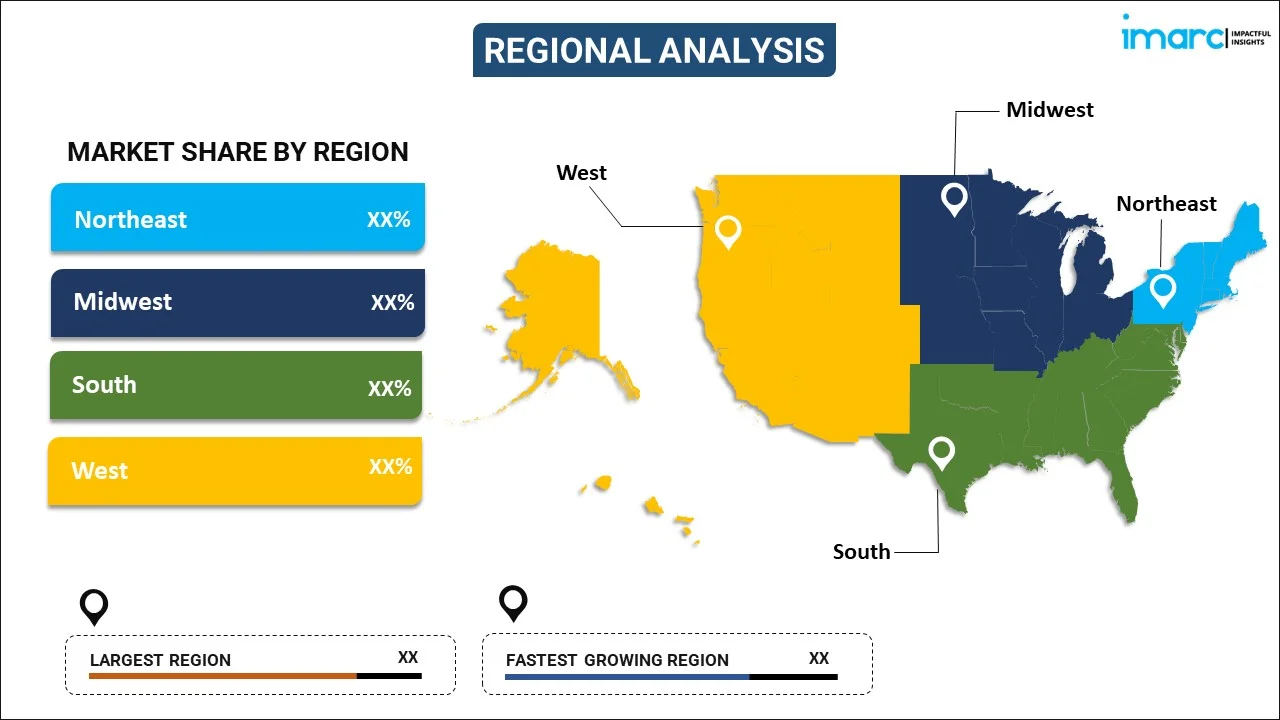
US Mutual Fund Market Report by Fund Type (Equity, Bond, Hybrid, Money Market), Investor Type (Households, Institutions), Channel of Purchase (Discount Broker/Mutual Fund Supermarket, Distributed Contribution Retirement Plan, Direct Sales From Mutual Fund Companies, Professional Financial Adviser), and Region 2025-2033
Market Overview:
US mutual fund market size reached USD 34.4 Billion in 2024. Looking forward, IMARC Group expects the market to reach USD 56.2 Billion by 2033, exhibiting a growth rate (CAGR) of 5.1% during 2025-2033. The increasing demand for online platforms, robo-advisors, and other innovations that can influence how investors access and manage their mutual fund investments, is primarily driving the market growth across the country.
|
Report Attribute
|
Key Statistics
|
|---|---|
|
Base Year
|
2024 |
|
Forecast Years
|
2025-2033
|
|
Historical Years
|
2019-2024
|
| Market Size in 2024 | USD 34.4 Billion |
| Market Forecast in 2033 | USD 56.2 Billion |
| Market Growth Rate (2025-2033) | 5.1% |
A mutual fund is a pooled investment vehicle that collects money from multiple investors and professionally manages it by investing in a diversified portfolio of stocks, bonds, or other securities. Investors purchase shares in the mutual fund, and the fund's value is determined by the performance of its underlying assets. Mutual funds are managed by professional fund managers who make investment decisions based on the fund's objectives and strategy. This allows individual investors to access a diversified portfolio without the need for extensive market knowledge or large amounts of capital. Mutual funds provide a convenient way for investors to achieve diversification, liquidity, and professional management, making them a popular choice for those seeking a hands-off approach to investing in financial markets.
US Mutual Fund Market Trends:
The mutual fund market in the US is multifaceted, influenced by a myriad of factors that collectively shape the dynamics of this financial ecosystem. Firstly, regional economic trends play a pivotal role in steering mutual fund performance. As economic conditions fluctuate, investors may adjust their portfolios, impacting the overall demand for mutual funds. Furthermore, geopolitical events serve as significant connectors between regional affairs and mutual fund markets. Political instability or trade tensions can create a ripple effect, prompting investors to reassess their risk tolerance and investment strategies. In addition to macroeconomic factors, interest rates act as crucial sentence connectors between central bank policies and mutual fund outcomes. Changes in interest rates affect the cost of borrowing, corporate profits, and investor sentiment, directly influencing mutual fund returns. Technological advancements also contribute to the evolving landscape, with innovations such as robo-advisors and algorithmic trading algorithms transforming how funds are managed and traded. Investor behavior forms another integral part of the mutual fund narrative, with market sentiment serving as a connecting thread between individual decisions and broader market trends. As investors react to news, market data, and emerging opportunities, collective actions create a dynamic interplay of forces that propel or restrain the mutual fund market. In essence, understanding these intricate connections provides a comprehensive insight into the driving forces that navigate the complexities of the mutual fund landscape.
US Mutual Fund Market Segmentation:
IMARC Group provides an analysis of the key trends in each segment of the market, along with forecasts at the country level for 2025-2033. Our report has categorized the market based on fund type, investor type, and channel of purchase.
Fund Type Insights:

- Equity
- Bond
- Hybrid
- Money Market
The report has provided a detailed breakup and analysis of the market based on the fund type. This includes equity, bond, hybrid, and money market.
Investor Type Insights:
- Households
- Institutions
A detailed breakup and analysis of the market based on the investor type have also been provided in the report. This includes households and institutions.
Channel of Purchase Insights:
- Discount Broker/Mutual Fund Supermarket
- Distributed Contribution Retirement Plan
- Direct Sales from Mutual Fund Companies
- Professional Financial Adviser
The report has provided a detailed breakup and analysis of the market based on the channel of purchase. This includes discount broker/mutual fund supermarket, distributed contribution retirement plan, direct sales from mutual fund companies, and professional financial adviser.
Regional Insights:

- Northeast
- Midwest
- South
- West
The report has also provided a comprehensive analysis of all the major regional markets, which include Northeast, Midwest, South, and West.
Competitive Landscape:
The market research report has also provided a comprehensive analysis of the competitive landscape in the market. Competitive analysis such as market structure, key player positioning, top winning strategies, competitive dashboard, and company evaluation quadrant has been covered in the report. Also, detailed profiles of all major companies have been provided.
US Mutual Fund Market Report Coverage:
| Report Features | Details |
|---|---|
| Base Year of the Analysis | 2024 |
| Historical Period | 2019-2024 |
| Forecast Period | 2025-2033 |
| Units | Billion USD |
| Scope of the Report | Exploration of Historical Trends and Market Outlook, Industry Catalysts and Challenges, Segment-Wise Historical and Future Market Assessment:
|
| Fund Types Covered | Equity, Bond, Hybrid, Money Market |
| Investor Types Covered | Households, Institutions |
| Channel of Purchases Covered | Discount Broker/Mutual Fund Supermarket, Distributed Contribution Retirement Plan, Direct Sales From Mutual Fund Companies, Professional Financial Adviser |
| Regions Covered | Northeast, Midwest, South, West |
| Customization Scope | 10% Free Customization |
| Post-Sale Analyst Support | 10-12 Weeks |
| Delivery Format | PDF and Excel through Email (We can also provide the editable version of the report in PPT/Word format on special request) |
Key Questions Answered in This Report:
- How has the US mutual fund market performed so far and how will it perform in the coming years?
- What has been the impact of COVID-19 on the US mutual fund market?
- What is the breakup of the US mutual fund market on the basis of fund type?
- What is the breakup of the US mutual fund market on the basis of investor type?
- What is the breakup of the US mutual fund market on the basis of channel of purchase?
- What are the various stages in the value chain of the US mutual fund market?
- What are the key driving factors and challenges in the US mutual fund?
- What is the structure of the US mutual fund market and who are the key players?
- What is the degree of competition in the US mutual fund market?
Key Benefits for Stakeholders:
- IMARC’s industry report offers a comprehensive quantitative analysis of various market segments, historical and current market trends, market forecasts, and dynamics of the US mutual fund market from 2019-2033.
- The research report provides the latest information on the market drivers, challenges, and opportunities in the US mutual fund market.
- Porter's five forces analysis assist stakeholders in assessing the impact of new entrants, competitive rivalry, supplier power, buyer power, and the threat of substitution. It helps stakeholders to analyze the level of competition within the US mutual fund industry and its attractiveness.
- Competitive landscape allows stakeholders to understand their competitive environment and provides an insight into the current positions of key players in the market.
Need more help?
- Speak to our experienced analysts for insights on the current market scenarios.
- Include additional segments and countries to customize the report as per your requirement.
- Gain an unparalleled competitive advantage in your domain by understanding how to utilize the report and positively impacting your operations and revenue.
- For further assistance, please connect with our analysts.
 Inquire Before Buying
Inquire Before Buying
 Speak to an Analyst
Speak to an Analyst
 Request Brochure
Request Brochure
 Request Customization
Request Customization




.webp)




.webp)












